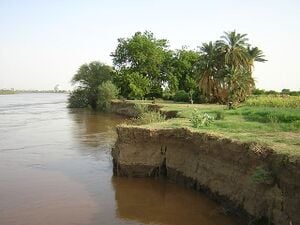
Desertification is a serious problem in Sudan. There is also concern over soil erosion. Agricultural expansion, both public and private, has proceeded without conservation measures. The consequences have manifested themselves in the form of deforestation, soil desiccation, and the lowering of soil fertility and the water table.
The nation's wildlife is threatened by poaching. As of 2001, twenty-one mammal species and nine bird species are endangered, as well as two species of plants. Critically endangered species include: the waldrapp, northern white rhinoceros, tora hartebeest, slender-horned gazelle, and hawksbill turtle. The Sahara oryx has become extinct in the wild.
Biodiversity[edit | edit source]
The main legislation governing wildlife is the Preservation of Wild Animals Act of 1935. This regulates hunting and trade and lists protected species. Game and wildlife tourism includes hunting for Eritrean gazelles, Nubian ibex and baboons in the area between the Nubian Desert and the Red Sea Hills. In the Western Desert, Barbary sheep, Arabian oryx, ostriches and red-fronted gazelles are also hunted, as well as ducks, guineafowl, bustards and doves. Overhunting, loss of habitat, and a lack of enforcement of regulations has led to a decline in populations and biodiversity. In 2015, the United Nations reported that 123 species in the country were listed as "threatened".
Among several protected areas in Sudan are Radom National Park in South Darfur, in the southwest of the country, and Dinder National Park in the southeast, both of which are UNESCO biosphere reserves. There are also a number of game reserves. The Suakin Archipelago National Park is a cluster of islands off the coast in the Red Sea and is a marine protected area of 579 square miles. These islets are fringed by coral reefs, being visited by four species of turtle and home to five species of breeding bird.
About Sudan[edit | edit source]
Sudan, officially the Republic of the Sudan, is a country in Northeast Africa. It borders the Central African Republic to the southwest, Chad to the west, Libya to the northwest, Egypt to the north, the Red Sea to the east, Eritrea and Ethiopia to the southeast, and South Sudan to the south. Sudan has a population of 50 million people as of 2024 and occupies 1,886,068 square kilometres (728,215 square miles), making it Africa's third-largest country by area and the third-largest by area in the Arab League. It was the largest country by area in Africa and the Arab League until the secession of South Sudan in 2011; since then both titles have been held by Algeria. Sudan's capital and most populous city is Khartoum.
External links[edit | edit source]
Wikipedia: Sudan